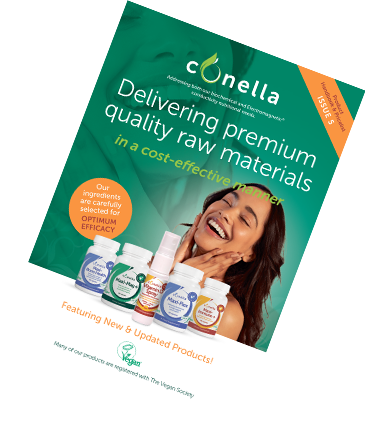What are they?
Probiotics are live bacteria, or microorganisms, found in the digestive tract which have been shown to benefit human health and contribute to a healthy microbiome. The microbiome refers to the balance of different types of bacteria in the gut and a healthy microbiome contains plenty of beneficial strains (or probiotics). Numerous studies show that a healthy microbiome can positively influence many aspects of human health, including digestion, mental health, and immunity.
Probiotics are found in certain fermented foods like yoghurt, kimchi (fermented and spiced vegetables), kombucha (fermented tea), sauerkraut (fermented cabbage), kefir (fermented milk or water), tempeh and miso (fermented soya). Probiotics may also be taken as a food supplement.
Probiotics are also passed from mother to baby via the birth canal during childbirth and via breast milk. The mother’s probiotic status is, therefore, an important consideration during pregnancy, given that her baby will also inherit the same microbiome.
There are a number of different probiotic strains, but the most studied strains with proven health benefits include Lactobacillus and Bifidobacterium varieties, as well as the yeast saccharomyces boulardii.
How do they work?
The health benefits of probiotics relate to the following mechanisms: -
- Improved integrity of the epithelial barrier
The epithelial barrier is a defence mechanism that helps to maintain the integrity of the gut and protect the rest of the body from bacteria, food antigens and other potentially toxic substances passing into the bloodstream and triggering an inflammatory response. Consumption of non-pathogenic bacteria can enhance this barrier function, and probiotic bacteria have been extensively studied for their involvement in the maintenance of this barrier. It is not yet fully understood how probiotics achieve this, but Lactobacillus, in particular, has been found to achieve positive results.
- Increased adhesion to the intestinal mucosa
For humans to benefit from probiotics, adhesion to the intestinal mucosa is essential. This adhesion enables modulation of the immune system and antagonism against pathogens. Various strains of Lactobacillus Acidophilus and Bifidobacterium have been shown in studies to have these adhesion properties.
- Inhibition of pathogen adhesion
Probiotics cause alterations in the intestinal mucins which prevent pathogens from binding to the intestinal barrier. These beneficial bacteria are degraded into antimicrobial peptides, which lends anti-pathogenic properties to the host when under attack from pathogens.
- Competitive exclusion of pathogenic microorganisms
Studies show probiotics, particularly Lactobacilli and Bifidobacterium, can crowd out and exclude pathogenic microorganisms.
- Production of anti-microorganism substances
Probiotics are involved in the production of several anti-microbial substances including organic acids, Bacteriocins, health promoting fatty acids and de-conjugated bile acids, all of which work to eliminate pathogens.
- Modulation of the immune system
Probiotics have been well researched for their immunomodulating properties. They can influence both the innate and adaptive immune systems and downregulate intestinal inflammation (Bermudez-Brito et al, 2012). Around 80% of human immune system cells are located in the gastrointestinal tract, therefore a healthy microbiome is vital in helping to maintain strong immunity (Furness et al, 1999).
- Production of indole-3 carbinole
In our recent article we talked about indole-3 carbinole, found in cruciferous vegetables (cauliflower, broccoli, brussel sprouts…), and how it may help to guard humans against non-alcoholic fatty liver disease. Indole-3 carbinole also plays an important role in metabolism and detoxification of hormones, helping to maintain balance and potentially reduce the risk of oestrogen dominant cancers and other disorders caused by hormone imbalances. The microbiome has also been shown to play a role in production of indole-3 carbinole. Indole-3 carbinole has also been shown to repress symptoms and inflammation from inflammatory bowel disease and help to prevent Dysbiosis (Busbee et al, 2020). Dysbiosis is when the microbiome becomes out of balance with too many pathogenic bacteria and not enough beneficial bacteria. So, there is this symbiotic relationship between our gut bacteria and indole-3 carbinole to which probiotics contribute.
How light may impact our microbiome
Reduced sunlight exposure has been associated with a negative impact on our microbiome and an increased risk of developing an inflammatory bowel disease such as Crohn’s or Ulcerative Colitis. A recent study carried out by Ghaly et al (2018) explored the impact of ultraviolet radiation on the microbiome of mice. They found the mice who had been irradiated to have a more diverse microbiome compared to the mice who had not received any exposure to UV. They also observed an anti-inflammatory effect on the digestion of mice treated with UV compared to the group who had not received this treatment.
In another study by Cui et al (2016), mice were exposed to light in different patterns, with one group having an irregular exposure to create a disrupted circadian rhythm scenario and the control group having regular light / dark exposure of 12 hours each. The group of mice with the disrupted light pattern were found to have a less beneficial microbiome.
A recent human study supports these findings, also demonstrating a potential link between UVB exposure and the human microbiome (Bosman et al, 2019).
What conditions might probiotics be helpful for?
Probiotics have numerous potential health benefits but the following outlines the key and most well-researched areas where probiotics are likely to have a positive impact:
Diarrhoea
Probiotics, particularly specific strains of Lactobacillus (Lactobacillus rhamnosus and Lactobacillus casei) and the yeast Saccharomyces Boulardii have been shown in studies to prevent or reduce the severity of diarrhoea. Antibiotic associated diarrhoea is common due to the medications causing an imbalance in gut bacteria, destroying much of the beneficial bacteria in the gastrointestinal tract. Probiotics help to rebalance the microbiome and replenish beneficial bacteria, hence reducing symptoms. In one study carried out by Hempel et al (2012), probiotics were found to reduce antibiotic-associated diarrhoea by 42%. But probiotics have been found to successfully reduce symptoms of other types of diarrhoea also, including infectious diarrhoea and traveller’s diarrhoea. A large review of 35 studies found certain strains of probiotics can reduce the duration of infectious diarrhoea by an average of 25 hours (Allen et al, 2010). Sazawal et al. (2006) found probiotics reduced the risk of traveller’s diarrhoea by 8% and lowered the risk of diarrhoea from other causes by 57% in children and 26% in adults.
Digestive Disorders
Probiotics have also been found to help improve or prevent attacks of other digestive disorders, including IBS, Crohn’s, ulcerative colitis, H-pylori and infection of the digestive tract caused by Clostridium difficile (Verna, 2010; Hungin et al, 2018). However further research is now needed to identify which specific strains are most appropriate for supporting patients with ulcerative colitis, Crohn’s and recurrence of pouchitis (a complication of surgery to treat ulcerative colitis).
Mental Health
There is a growing body of research linking human gastrointestinal health to mental health (Steenbergen et al, 2015). In a review of 15 human studies, Wang et al (2016) found supplementing with Bifidobacterium and Lactobacillus strains for 1–2 months can improve anxiety, depression, autism, obsessive-compulsive disorder (OCD) and memory. In another study, 40 depression patients were administered probiotic supplements for 8 weeks. At the end of the 8-week period, the patients who had received probiotics all had decreased depression levels and c-reactive protein (a marker for inflammation) and hormones such as Insulin, compared to those who were not given a probiotic (Akkasheh et al, 2016).
Immunity
We have already touched on probiotics potential ability to help modulate the immune system via the above mechanisms of action. Probiotics improve the quality of the microbiome, inhibit pathogens, improve gut integrity and produce substances which destroy pathogens (Galdeano, 2019). Some probiotics have even been shown to promote the production of natural antibodies in the body. They may also boost immune cells like the IgA-producing cells, T lymphocytes and natural killer cells. Azad et al. (2018) carried out a review of recent research on the impact probiotics have on the immune system. The study findings confirmed these claims, although further research is needed to understand in more detail how probiotics induce immunomodulatory effects in the treatment of inflammation.
Wang et al. (2016) carried out a systematic review and meta-analysis of randomised controlled trials in relation to the use of probiotics for treating children suffering respiratory tract infections. The study concluded that based on the available data, probiotic consumption appears to be a feasible way to decrease the incidence of RTIs in children.
Based on the available evidence, it seems apparent that probiotics may help to boost immunity and help to fight infections.
Eczema
Studies have shown probiotics may be effective in prevention of eczema. One study investigated whether maternal probiotic supplementation during pregnancy and breast-feeding reduced the chances of high-risk infants, from an atopic mother, developing eczema. The study found that mothers who took probiotics during pregnancy and breastfeeding resulted in their children having an 83% lower risk in developing eczema in the first 2 years of their lives (Rautava et al, 2012). However, probiotic treatment of established eczema has yet to be firmly proven as successful. Existing research has yielded mixed results. A 2008 review of 12 trials found no differences in outcomes related to the use of probiotics and placebos (Boyle et al, 2008). The strain of probiotic is an important factor influencing treatment outcomes. It seems that high doses (3-50 billion CFu/d) of Lactobacillus rhamnosus, Bifidobacterium lactis and Lactobacillus acidophilus probiotics in single or multi-strain formulations currently hold the most promise for prevention and treatment of eczema (Schettle and Lio, 2020).
Weight Loss
There is significant research to suggest that some probiotic strains may help with weight loss through various mechanisms. Some probiotics may prevent absorption of fat into the intestines so that it is excreted rather than stored (Ogawa et al, 2015).
Probiotics may also help people to feel fuller for longer and burn more calories, due to increasing levels of certain hormones like GLP-1 (Yadav et al, 2013).
In one study, women on a calorie restrictive diet were also administered with Lactobacillus rhamnosus for 3 months. These women’s weight loss was compared with another group of women on the same diet but who were not given probiotic supplements. Those taking Lactobacillus rhamnosus lost 50% more weight than women who didn't take a probiotic (Sanchez et al, 2014). This certainly suggests certain probiotic strains may help to boost weight loss. However, research carried out on different probiotic strains, such as Lactobacillus acidophilus found these strains may enhance weight gain, suggesting the strain of probiotic is key to successful weight loss (Million et al, 2012).
Vaginal and Urinary Tract Infections
Due to women having a much shorter urethra than men, urinary tract infections are extremely common because it is much easier for bacteria to make its way into the urinary tract. These infections appear to become even more common post-menopause when oestrogen and progesterone levels drop. Other common infections include candida and bacterial vaginosis which occur when the vaginal microbiome becomes out of balance and an overgrowth of certain bacteria occur.
Studies have shown oral consumption of probiotics to be effective in reducing occurrence of urogenital complaints in women. One study aimed to compare probiotic therapy versus a placebo in Oxidative Stress Values (OSVs) and histological features in urogenital infections in female patients. Results from the study showed a significantly positive difference amongst the test group, confirming use of probiotics as a potential treatment or at least preventative for urogenital infections. (Ballini et al, 2018).
Plant-Based diet, the Microbiome and Cardiovascular Health
Research suggests that a plant-based diet may have a positive influence on cardiovascular health by influencing the gut microbiome pattern to favour beneficial strains of bacteria and minimising the adverse effects of a gut microbiome metabolite associated with increased risk of coronary heart disease (Wilson Tang, 2019; Masterson, 2020).
Which Probiotic is Right for Me?
There are many different probiotic cultures, each with their own set of health benefitting properties. The following table provides a summary of the key health benefits of each different strain: -
|
Probiotic Culture |
Properties |
|
Bifidobacterium Bifidum |
Supports production of vitamins in the gut Inhibits harmful bacteria Supports immune system response Helps prevent diarrhoea |
|
Lactobacillus Acidophilus |
Relieves gas and bloating Improves lactose intolerance Reduces presence of e coli Helps lower cholesterol levels Helps in creation of vitamin K Important in GALT immune strength |
|
Bifidobacterium Longum |
Supports liver function Reduces inflammation Supports eradication of lead and heavy metals |
|
Lactobacillus Casei |
Supports immunity Inhibits h-pylori Helps fight infections
|
|
Bifidobacterium Infantis |
Alleviates IBS symptoms, diarrhoea and constipation |
|
Lactobacillus Brevis |
Shown to survive the GI tract Boosts cellular immunity Enhances natural Killer cells Kills h pylori (pathogenic bacteria) |
|
Bifidobacterium Breve |
Helps to crowd out pathogenic bacteria |
|
Lactobacillus Bulgaricus |
Powerful probiotic shown to fight harmful bacteria that invades the GI tract Stable enough to withstand acidic environment of the stomach Neutralises toxins Produces its own antibiotics |
|
Lactobacillus Rhamnosus |
Supports bacterial balance and healthy skin Helps fight urinary tract and respiratory infections May help reduce anxiety by reducing stress hormones and GABA neurotransmitter receptors Survives the GI tract
|
|
Saccharomyces Boulardii |
A yeast probiotic Helps restore natural flora in the large and small intestine and improves intestinal cell growth Been found to improve symptoms in IBD Anti-toxin Antimicrobial Reduces inflammation |
|
Lactococcus Lactis |
Boosts the immune system May help to combat allergies, hypertension and IBD Positively impacts on skin health |
Of course, everyone’s digestive environment is different and unique. It is therefore the practitioner’s job to identify which specific probiotic cultures are appropriate for each client by assessing their individual symptoms and potentially carrying out some testing to gain a greater picture of the client’s microbiome and how it may be improved.
Probiotic safety
Probiotics are generally considered to be safe and there are no known interactions with medications.
Caution
Probiotics should not be administered to patients who are immunocompromised (e.g. chemotherapy), chronically ill or hospitalised with GI Disorders. Indwelling catheters may predispose patients to probiotic sepsis, specifically, in GI disorders in which gut permeability and gut immunity may be compromised, adding probiotics may increase translocation of bacteria into the bloodstream and should therefore be avoided (Verna, 2010).
Side Effects
Minor gastrointestinal side effects, such as gas and bloating may occasionally be experienced by some patients.
References
Akkasheh, G. et al. (2016). Clinical and metabolic response to probiotic administration in patients with major depressive disorder: A randomized, double-blind, placebo-controlled trial. Nutrition. 32(3):315-20. Available at: https://www.ncbi.nlm.nih.gov/pubmed/26706022 (Accessed 03/02/20)
Allen, S.J. et al. (2010). Probiotics for treating acute infectious diarrhoea. The Cochrane Database of systematic reviews. 10(11):CD003048. Available at: https://www.ncbi.nlm.nih.gov/pubmed/21069673 (Accessed 03/02/20)
Ballini, A. et al. (2018). Probiotics Improve Urogenital Health in Women. Open access Macedonian journal of medical sciences. 6(10): 1845–1850. Available at: https://www.ncbi.nlm.nih.gov/pmc/articles/PMC6236028/ (Accessed 05/02/20)
Bermudez-Brito, M. et al. (2012). Probiotic Mechanisms of Action. Annals of Nutrition and Metabolism. 61(2): 160-174. Available at: https://www.karger.com/Article/FullText/342079 (Accessed 03/02/20)
Bosman, E.S. et al. (2019). Skin Exposure to Narrow Band Ultraviolet (UVB) Light Modulates the Human Intestinal Microbiome. Frontiers in Microbiology. doi: 10.3389/fmicb.2019.02410. Available at: https://www.frontiersin.org/articles/10.3389/fmicb.2019.02410/full (Accessed 28/02/20)
Boyle, R.J. et al. (2008). Probiotics for treating eczema. Cochrane database of systematic reviews. 8;(4):CD006135. Available at: https://www.ncbi.nlm.nih.gov/pubmed/18843705 (Accessed 05/02/20)
Busbee, P.B. et al. (2020). Indole-3-carbinol prevents colitis and associated microbial dysbiosis in an IL-22–dependent manner. JCI Insight. 5(1):e127551. Available at: https://insight.jci.org/articles/view/127551/pdf (Accessed 22/02/20)
Corcoran, B.M. et al. (2005). Survival of Probiotic Lactobacilli in Acidic Environments Is Enhanced in the Presence of Metabolizable Sugars. Applied and Environmental Microbiology. 71(6): 3060–3067. Available at: https://www.ncbi.nlm.nih.gov/pmc/articles/PMC1151822/ (Accessed 06/02/20)
Cui, M. et al. (2016). Circadian Rhythm Shapes the Gut Microbiota Affecting Host Radiosensitivity. International Journal of Molecular Sciences. 17 (11). Available at: https://pubmed.ncbi.nlm.nih.gov/27792172-circadian-rhythm-shapes-the-gut-microbiota-affecting-host-radiosensitivity/ (Accessed 28/02/20)
Deaver, J.A. et al. (2018). Circadian Disruption Changes Gut Microbiome Taxa and Functional Gene Composition. Frontiers in Microbiology. 9: 737. Available at: https://www.ncbi.nlm.nih.gov/pmc/articles/PMC5909328/ (Accessed 22/02/20)
Furness, J.B. et al. (1999). Nutrient tasting and signaling mechanisms in the gut. II. The intestine as a sensory organ: neural, endocrine, and immune responses. The American Journal of Physiology. 277(5):G922-8. Available at: https://www.ncbi.nlm.nih.gov/pubmed/10564096 (Accessed 03/02/20)
Galdeano, C. M. et al. (2019). Beneficial Effects of Probiotic Consumption on the Immune System. Annals of nutrition and metabolism. 74(2):115-124. Available at: https://www.ncbi.nlm.nih.gov/pubmed/30673668 (Accessed 05/02/20)
Ghaly, S. et al. (2018). Ultraviolet Irradiation of Skin Alters the Faecal Microbiome Independently of Vitamin D in Mice. Nutrients. 10(8): 1069. Available at: https://www.ncbi.nlm.nih.gov/pmc/articles/PMC6116187/ (Accessed 22/02/20)
Goldenberg, J.Z. et al. (2015). Probiotics for the prevention of pediatric antibiotic-associated diarrhea. The Cochrane Database of Systematic Reviews. 22(12):CD004827. Available at: https://www.ncbi.nlm.nih.gov/pubmed/26695080 (Accessed 03/02/20)
Hartel, C. et al. (2017). Lactobacillus acidophilus/Bifidobacterium infantis probiotics are associated with increased growth of VLBWI among those exposed to antibiotics. Scientific Reports. 7: 5633. Available at: https://www.ncbi.nlm.nih.gov/pmc/articles/PMC5514087/ (Accessed 31/01/20)
Hempel, S. et al. (2012). Probiotics for the prevention and treatment of antibiotic-associated diarrhea: a systematic review and meta-analysis. JAMA. 307(18):1959-69. Available at: https://www.ncbi.nlm.nih.gov/pubmed/22570464 (Accessed 03/02/20)
Hungin, A.P.S. et al. (2018). Systematic review: probiotics in the management of lower gastrointestinal symptoms – an updated evidence‐based international consensus. Alimentary Pharmacology & Therapeutics. 47(8): 1054–1070. Available at: https://www.ncbi.nlm.nih.gov/pmc/articles/PMC5900870/ (Accessed 05/02/20)
Islam, S.U. (2016). Clinical Uses of Probiotics. Medicine. 95(5): e2658. Available at: https://www.ncbi.nlm.nih.gov/pmc/articles/PMC4748908/ (Accessed 03/02/20)
Johnston, J.C. (2011). Probiotics for the prevention of pediatric antibiotic-associated diarrhea. 9(11):CD004827. Available at: https://www.ncbi.nlm.nih.gov/pubmed/22071814 (Accessed 03/02/20)
Kligler, B. and Cohrssen, A. (2008). Probiotics. American Family Physician. 78(9):1073-1078. Available at: https://www.aafp.org/afp/2008/1101/p1073.html (Accessed 06/02/20)
Li, S-C. et al. (2019). Combination of Lactobacillus acidophilus and Bifidobacterium animalis subsp. lactis Shows a Stronger Anti-Inflammatory Effect than Individual Strains in HT-29 Cells. Nutrients. 11(5): 969. Available at: https://www.ncbi.nlm.nih.gov/pmc/articles/PMC6566532/ (Accessed 31/01/20)
Million, M. et al. (2012). Comparative meta-analysis of the effect of Lactobacillus species on weight gain in humans and animals. Microbial Pathogenesis. 53(2):100-8. Available at: https://www.ncbi.nlm.nih.gov/pubmed/22634320 (Accessed 05/02/20)
Ogawa, A. et al. (2015). Lactobacillus gasseri SBT2055 suppresses fatty acid release through enlargement of fat emulsion size in vitro and promotes fecal fat excretion in healthy Japanese subjects. Lipids in Health and Disease. 20;14:20. Available at: https://www.ncbi.nlm.nih.gov/pubmed/25884980 (Accessed 05/02/20)
Rautava, S. et al. (2012). Maternal probiotic supplementation during pregnancy and breast-feeding reduces the risk of eczema in the infant. The Journal of allergy and clinical immunology. 130(6):1355-60. Available at: https://www.ncbi.nlm.nih.gov/pubmed/23083673 (Accessed 05/02/20)
Sanchez, M. et al. (2014). Effect of Lactobacillus rhamnosus CGMCC1.3724 supplementation on weight loss and maintenance in obese men and women. The British Journal of Nutrition. 111(8):1507-19. Available at: https://www.ncbi.nlm.nih.gov/pubmed/24299712 (Accessed 05/02/20)
Sazawal, S. et al. (2006). Efficacy of probiotics in prevention of acute diarrhoea: a meta-analysis of masked, randomised, placebo-controlled trials. The Lancet. Infectious Diseases. 6(6):374-82. Available at: https://www.ncbi.nlm.nih.gov/pubmed/16728323 (Accessed 03/02/20)
Shigwedha, N. and Jia, L. (2013). Bifidobacterium in Human GI Tract: Screening, Isolation, Survival and Growth Kinetics in Simulated Gastrointestinal Conditions. Lactic Acid Bacteria - R & D for Food, Health and Livestock Purposes, Marcelino Kongo, IntechOpen, DOI: 10.5772/50457. Available from: https://www.intechopen.com/books/lactic-acid-bacteria-r-d-for-food-health-and-livestock-purposes/bifidobacterium-in-human-gi-tract-screening-isolation-survival-and-growth-kinetics-in-simulated-gast (Accessed 06/02/20)
Steenbergen, L. et al. (2015). A randomized controlled trial to test the effect of multispecies probiotics on cognitive reactivity to sad mood. Brain, Behaviour and Immunity. 48:258-64. Available at: https://www.ncbi.nlm.nih.gov/pubmed/25862297 (Accessed 03/02/20)
Verna, E.C. (2010). Use of probiotics in gastrointestinal disorders: what to recommend? Therapeutic Advances Gastroenterology. 3(5): 307–319. Available at: https://www.ncbi.nlm.nih.gov/pmc/articles/PMC3002586/ (Accessed 03/02/20)
Wang, H. et al. (2016). Effect of Probiotics on Central Nervous System Functions in Animals and Humans: A Systematic Review. Journal of Neurogastroenterology and Motility. 22(4):589-605. Available at: https://www.ncbi.nlm.nih.gov/pubmed/27413138 (Accessed 03/02/20)
Wang, Y. et al. (2016). Probiotics for prevention and treatment of respiratory tract infections in children. Medicine. 95(31): e4509. Available at: https://www.ncbi.nlm.nih.gov/pmc/articles/PMC4979858/ (Accessed 05/02/20)
Wilson Tang, W.H. et al. (2019). Intestinal Microbiota in Cardiovascular Health and Disease: JACC State-of-the-Art Review. Journal of the American College of Cardiology. 73(16): 2089-2105. Available at: https://www.sciencedirect.com/science/article/pii/S0735109719339622 (Accessed 28/02/20)
Yadav, H. et al. (2013). Beneficial metabolic effects of a probiotic via butyrate-induced GLP-1 hormone secretion. The Journal of Biological Chemistry. 288(35):25088-97. Available at: https://www.ncbi.nlm.nih.gov/pubmed/23836895 (Accessed 05/02/20)
Additional Reading
Axe, J. (2020). Beneficial Probiotic Strains. Available at: https://www.google.com/search?q=Dr+Axe+probiotic+table&tbm=isch&source=iu&ictx=1&fir=OPglJ22pjsT_sM%253A%252C36QkvW6QUlnG0M%252C_&vet=1&usg=AI4_-kQzxHBVbSgyMQ34m5s_zakyhqT_Nw&sa=X&ved=2ahUKEwjchePiuuXnAhVWXRUIHdtxDxcQ9QEwEXoECAgQBQ#imgrc=OPglJ22pjsT_sM:&vet=1 (Accessed 22/02/2020)
Brown, M.J. (2016). 8 Health Benefits of Probiotics. Healthline. Available at: https://www.healthline.com/nutrition/8-health-benefits-of-probiotics (Accessed 31/01/20)
Dilonardo, M.J. (2020). When Can Probiotics Help? Available at: https://www.webmd.com/digestive-disorders/features/probiotics-benefits#1 (Accessed 05/02/20)
Harvard Health Publishing (2020). Health benefits of taking probiotics. Available at: https://www.health.harvard.edu/vitamins-and-supplements/health-benefits-of-taking-probiotics (Accessed 31/01/20)
Masterson, D. (2020). Plant-based diet may help boost bacteria that protects heart health. CBD Global Summit 2020. Available at: https://www.nutraingredients-usa.com/Article/2020/02/18/Plant-based-diet-may-help-boost-bacteria-that-protects-heart-health-Study?utm_source=copyright&utm_medium=OnSite&utm_campaign=copyright (Accessed 28/02/20)
National Center for Complementary and Integrative Health (2019). Probiotics: What You Need To Know. Available at: https://nccih.nih.gov/health/probiotics/introduction.htm (Accessed 31/01/20)
Nordqvist, J. (2017). Benefits of probiotics. Medical News Today. Available at: https://www.medicalnewstoday.com/articles/264721.php (Accessed 31/01/20)
Novkovik, B. (2020). Top 8 Health Benefits of Lactococcus lactis (L. lactis). Available at: https://selfhacked.com/blog/l-lactis/ (Accessed 22/02/2020)
Schettle, L. and Lio, P.A. (2020). Probiotics: The Search for Bacterial Balance. National Eczema Association. Available at: https://nationaleczema.org/search-bacterial-balance/ (Accessed 05/02/20)
WebMD. (2020). What are Probiotics? Available at: https://www.webmd.com/digestive-disorders/what-are-probiotics#1 (Accessed 03/02/20)
How a plant-based diet can boost bacteria that protect your heart health
How sunlight positively influences our gut microbiomes and therefore our digestive health.










